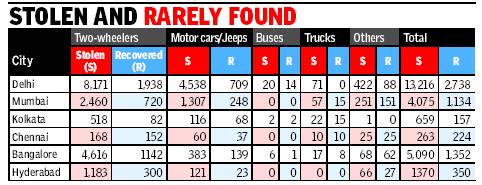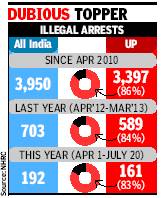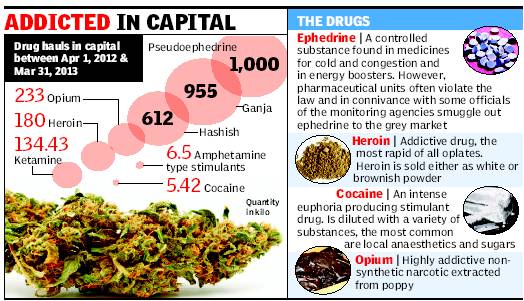Crime: India
This is a collection of newspaper articles selected for the excellence of their content. |
Contents |
2012: Crime in India's 5 biggest cities
Delhi’s dubious distinction: Maximum murders
NCRB Report For 2012 Reveals That 408 People, Double The Figure In Mumbai, Murdered In City
Dwaipayan Ghosh TNN 2013/06/14
New Delhi: The National Crime Records Bureau (NCRB) report for 2012 has confirmed the notion that it is still some time before Delhi can shed its ‘crime capital’ tag. Though the city showed some promise—doing much better than earlier years in containing street crime—the total number of grievous cases registered last year show that only robust policing can bring down crime. An analysis with other cities perhaps explains Delhi’s own set of problems.
According to the NCRB data, 408 murders took place in Delhi last year—highest among 88 cities—while there were only 215 murders in Mumbai, 180 in Chennai and 85 in Kolkata. However, Delhi Police claimed street crime was down, pointing out that Mumbai registered 29 dacoity and 1131 robbery cases while the capital recorded just 13 dacoity and 522 robberies in the same time. Similarly, though there were 369 instances of attempt to murder in the city —higher than 170 registered in Mumbai and 154 in Kolkata—it is Bangalore with 454 which tops the city table.
Certain crimes in Delhi are at least 10 times more than the other cities. Take kidnapping and abduction cases. While Delhi has registered 3274 registered cases, the next city to even come near this figure is Bangalore with 532 cases. Delhi Police though dismiss this as a “wrong analysis”. An officer explained: “We register a kidnapping case when any minor girl goes missing under directions of the court. Show me another city which does this.”
An interesting figure highlighted in the NCRB data is that a total of 20,99,170 complaints were received in Delhi in writing and on phone, including helplines, the most important one being 100. Yet, only a fraction, 60,397, was converted into cases. The corresponding figure for Maharashtra is 94,3994 and about 3,33,680 were turned into complaints.
Cops say NCRB has “confused” normal PCR calls with genuine distress calls. “Our PCR nerve centre receives over 50,000 calls a day. Will you count complaint of power failure or information sought on DTC routes as a genuine complaint?” asked a bemused cop. But then again, while the Maharashtra police took suo moto cognizance in 77,3376 cases, Delhi Police took suo moto cognizance in 13,318 cases.
In a reply to a question by BJP MLA Sahib Singh Chauhan (No. 237) about the total number of incidents of kidnapping, rape and dacoity in the city in the past 10 years, the Delhi government had stated that “bad and perfunctory investigation” along with “noncollection of scientific evidence during the course of investigation” were reasons behind the low conviction rate (around 30 per cent) in these heinous crimes.
“The large expansion of new colonies like Dwarka and Rohini and thousands of unplanned colonies is a critical crimogenic factor, particularly in respect of street crimes like robberies and snatching,” the written answer had said. The fact that most murders in the past three years have been reported from the border districts (268 of 521), the observation makes sense.
The cops list a number of new initiatives, including. a web-based information system for history-sheeters and a fingerprint bank of over 2.25 lakh criminals.
Car Thefts 2012
Biggest haul by car thieves in
Dwaipayan Ghosh TNN
New Delhi: The city that is obsessed with cars also has the largest number of vehicle thefts. The National Crime Records Bureau (NCRB) report for 2012 reveals that the total number of vehicles stolen from this city is more than the figure of Mumbai, Kolkata, Bengaluru, Hyderabad and Chennai put together.
There were 13,216 vehicle thefts in the capital last year when 11,457 vehicles were stolen from the five other cities. However, the city cops did a comparatively good job — though far short of the mark — of recovering the vehicles. While 2,738 vehicles were recovered in the capital, the other five cities recovered 3,227.
While 8,171 scooters and bikes were stolen, 4,538 cars and jeeps were taken away. The city also witnessed 20 buses and 71 trucks being stolen by organized gangs. Among the 422 other vehicles stolen were tractors, carts and three-wheelers. On all individual counts, the city witnessed the largest number of thefts. Bangalore (5,090) was a distant second, followed by Mumbai (4,075) and Hyderabad (1,370).
Senior officers said that with the city having the highest density of vehicles, the theft figure was way below world standards. It is indeed a fact that Delhi was the city with the highestregistration of vehicles in the country, both in 2011 and 2012, but Bangalore is showing a similar trend. In 2011, Delhi witnessed 4.76 lakh vehicles being registered while till November 2012, it saw 3.99 lakh registrations that year. On the other hand, Bangalore witnessed a huge jump, from 2.72 lakh vehicle registrations in 2011 to 3.28 lakh till November 2012. Cops claim motor vehicle thefts have come down over the past few years but unless people themselves take some basic security measures and parking issues are addressed, there cannot be any dramatic change. The cars stolen in the capital are often seized in other states and better coordination with the police force of other states can definitely speed up recovery.
The special cell has been given the task of coordination with Jammu and Kashmir while the crime branch will coordinate with police near the Nepal border and in northeastern states. Likewise, the police from other Delhi districts have been assigned the task of coordinating with their counterparts in neighbouring states. Police sources said most of the arrested car lifters revealed that they preferred to sell stolen vehicles in the northeastern states and Jammu and Kashmir.
Illegal arrests
UP accounts for over 80% of illegal arrests in India
Ahead Of No. 2 Delhi By 3,000%
Deeptiman Tiwary TNN
New Delhi: Uttar Pradesh’s high-handedness is not just reflected in the arbitrary transfer of officers such as Durga Sakthi Nagpal and slapping of bogus cases against dissenters (as in the case of Dalit scholar Kanwal Bharti), it can also be seen in the massive number of illegal arrests made by the UP police.
According to National Human Rights Commission data, UP records an overwhelming majority of illegal arrests in the country, accounting for more than 80% of all such cases. In fact, it tips its nearest competitor, Delhi, by over3,000% almost year after year.
In the past three years (April 2010 to July 2013), UP accounted for 3,397 illegal arrests out of 3,950 such cases recorded across India by NHRC. The count for the rest of the 27 states and seven union territories put together was just 553.
“What do you expect from a state where many politicians themselves are criminals? How do you expect them to have any respect for law and order or human rights?” says Colin Gonsalves of Human Rights Law Network.
From April 2012 to March 2013, NHRC recorded 703 cases of illegal arrests in all. As many as 589 of these were against the UP police. UP accounts for 161 of 192 illegal arrests in ’13
Its closest rivals in this dubious distinction, Uttarakhand and Delhi, were way behind with 14 cases each. Data for this period shows only two other states where the number of illegal arrests had crossed double figures — Karnataka (12) and Andhra Pradesh (10).
In 2013 too (April 1 to July 20), UP accounted for 161 such cases of the total of 192 recorded by NHRC in the entire country. Its closest rival, Delhi, was again was behind with only five cases.
Year 2011 was the worse for UP, with the state police being at the wrong end of the law 1,101 times of the total of 1,249 cases registered by NHRC. Delhi again took the second spot with 38 cases. In 2010 too UP recorded 1,546 such cases of the total of 1,716. These are cases that were brought to NHRC’s notice. The real figures for both UP and other states are bound to be higher as many complainants go to state human rights commissions instead of knocking at NHRC’s doors.
Conversely, sources say, UP being closer to Delhi, more people may tend to approach NHRC in the capital. But if that was true, neighbouring Haryana would also show a high number of illegal arrests. However,Haryana’s figures for many years have remained in single digits.
Narcotics
Delhi transit hub in narcotics corridor
Dwaipayan Ghosh TNN
New Delhi: Data released by Narcotics Control Bureau on International Day Against Drug Abuse has once again shown how Delhi is rapidly emerging as a transit point of high-end drugs smuggled by international cartels.
While the capital lags behind other states in use of ganja and opium, it ranks high in consumption of party drugs such as ketamine and cocaine. Maharashtra is the top consumer of party drugs, according to this data. Between April 1, 2012 and March 31, 2013, a total of 143.43kg ketamine has been seized in Delhi compared to Maharashtra (2,170kg) and Tamil Nadu (596kg). Ketamine is produced illegally in the latter states for supply to southeast Asian countries. The fact that Delhi ranks three on the list when it is not even a major producer indicates it is a transit point. Police said this is due to its unique location between producers Afghanistan and Commonwealth of Independent States nations and consumers in southeast Asia.
According to top officers in the narcotics wing and NCB officials, pseudoephedrine—used to make party drugs like ‘Speed’ and ‘Ecstasy’—is a good example of a transit drug. The total seizure of pseudoephedrine in the past one year in north, east and northeast India have been more than 4,500kg.
The figures also include a cocaine haul of 5,429kg and 180kg heroin. The cocaine circuit is dominated by African cartels who also engage in heroin trade. But most of the heroin seized in the capital are of southwest Asian origin and enters India through Pakistan border, says an NCB study.
Security agencies have long believed that some of the money in this trade is actually a portion of narco-terrorism wherein profits from selling this drug is used to fund terror activities. A total of 612.08kg hashish, 955.58kg ganja and 233.42kg opium were also seized from the capital in this one year. A new item on the list is ATS (amphetamine-type stimulants). Over 6.5kg ATS was seized in the city vis-à-vis Maharashtra (40kg).
“It is believed that, due to establishment of special ATS labs, some foreign operatives are using the country’s huge chemical base to source raw materials and produce such drugs. Drug hauls on Delhi-Manipur route show they are being trafficked to Myanmar,” the NCB noted.
“Recent seizures of Kolkatabound consignments in eastern and northern India indicate that the mafia is using West Bengal's ports to smuggle banned drugs to South America. A group of pharmaceutical companies are handing out stocks from Uttarakhand. This is then brought to Delhi en route to northeast, Myanmar and Thailand. The processing is completed in factories there before the drugs are pushed backed to India. While a portion returns to party circles in Delhi and Mumbai, the rest is shipped out to Colombia and Uruguay where these drugs are in high demand,” said an NCB official.
NCB also asked agencies to crack down on abuse of prescription drugs with the smuggling of codeine-based Phensedyl increasing across borders.
Violent crimes 2012
Violent crimes highest in UP in 2012
In violent crimes, UP tops list: National Crime Research Bureau
Isha Jain, TNN | Jun 22, 2013
LUCKNOW: The annual report of National Crime Research Bureau (NCRB) has revealed that Uttar Pradesh tops the list of states in terms of murders. Also, UP has earned the credit for maximum number of kidnappings, dowry related deaths and robberies in the year 2012. (Editor: UP is the most populous state of India. Hence absolute numbers do not convey the true picture. A better yardstick would be ‘violent crimes per 1,000 of population.’)
Not only this, but UP has for the third consecutive year retained its top position in violent crimes. The state reported a total of 33,824 incidents in 2012. This included 4,966 murders, 8,878 kidnappings, 3,159 robberies, 2,244 dowry deaths along with other major crimes, according to NCRB. In 2010, UP accorded 27,225 cases of violent crimes followed by 32,987 in 2011.
NCRB data revealed that it is not [a] specific age group which is committing crimes. Rather, people from all age groups are indulging in it. In 2012 alone, 10.7% of the total crimes were committed by people of above 50 years. Those between 18-30 years committed 46% crime. As high as 15% of the total offenders were women.
Social activists say that present situation of increasing crime is worrisome. "There is no stringent punishment for the criminals. As a result, they walk freely with head high on the streets," said an activist.



